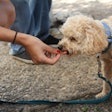.png?auto=format%2Ccompress&q=70&w=400)
"Immediate acceptance of offered food is often the pet owner's criterion for nutritional desirability," said Slobodan Baskot, R&D assistant at BHJ Pet Food, in a March 2007 article in Petfood Industry . But what does it take to make tails start wagging and tongues drool when it's feeding time for consumers' cats and dogs? Petfood has to be palatable, healthy, nutrition-rich and above all, safe to eat. That's where our industry's finicky and discerning taste-testers come in, ready to put our culinary offerings to the test.
Palatability testing: CPAP
According to CanCog, palatability is a measure of subjective food preference and depends on taste, texture and odor. Research into the palatability of petfood products has always been important because no matter how well-formulated a petfood may be, all the nutrition in the world won't matter one bit if the animal won't eat it. Testing conducted on the application of palatant systems and alternative kibble formulations is often the best solution. Canned, semi-moist and dry pet products can be evaluated in terms of palatability, while extruded products can be measured for texture and shape.
Cognitive palatability assessment protocol (CPAP) is the use of associative learning to assess palatability in companion animals. Response choices are indicative of food preference since the preferred stimulus is associated with no reward and the non-preferred stimuli are associated with test foods. A preferred stimulus of three, instead of two, is determined through discrimination testing and reversal, which provides quality assurance (see Figure 1).
Dogs tested using this method by CanCog showed increased preferences on CPAP, suggesting a learning component. Animals also showed a greater ability to detect differences, particularly when they were not previously exposed to food. The researchers at CanCog concluded that CPAP would be useful for:
-
Avoiding confounding food effects (satiety);
-
Drug studies and understanding taste mechanisms;
-
Long-term palatability testing; and
-
Testing products consumed in small quantities (treats and pharmaceuticals).
Palatability testing: two pan tests
At Summit Ridge Farms, palatability dogs and cats are chosen by using science and accurate validation procedures, according to the protocol testing facility. The "taste testers" undergo extensive training and validation. The animals are introduced to two bowl feeding stations and then the temperament of each animal is monitored, including its acceptability of two bowl feedings, and the dog's or cat's willingness to make a choice. Panels are periodically validated by presenting the same diets simultaneously to verify a null response. The animals are then offered a highly palatable diet versus a standard diet to verify a positive response.
The patent pending Palatability Monitoring System from Summit Ridge collects data for true side-by-side, two bowl palatability testing of group housed cats. The feeding trial company has developed hardware and software that allows them to provide historical data, as per standard two bowl palatability testing, with the addition of timed-event-consumption data. The system also provides continuous palatability recording in a community environment with data acquisition and analysis that allows Summit Ridge to present data in multiple formats. Up to 40 feeding stations can be used with one central computer via USB connection; the company is currently developing stations that operate wirelessly.
Dental testing
Dental testing feeding trials are the evaluation of products that make dental health claims for acceptance and efficacy. Summit Ridge Farms is one US facility that runs these important trials. The Veterinary Oral Health Council (VOHC) has set stringent guidelines that must be met for a product to maintain the VOHC Seal of Approval. Periodontal disease is the most common disease occurring in dogs and cats, and pet owners have begun to recognize the importance of dental health, often seeking out products with the VOHC Seal.
AAFCO nutritional adequacy testing
When a diet is fed as the sole source of food to a population of companion animals, problems are more readily identified within a controlled environment. According to Canine and Feline Nutrition - A Resource for Companion Animal Professionals , testing food through a series of feeding trials is the most thorough and reliable evaluation method available. Summit Ridge also conducts Association of American Feed Control Officials (AAFCO) nutritional adequacy testing.
In 1975, AAFCO developed Policy Statement 21 (a) and 21 (b), which were to become approved statements for nutritional adequacy. Policy Statement 21 was developed jointly by the Pet Food Institute (PFI) and the AAFCO Pet Food Committee and in 1980 was adopted. This policy statement required that labels show the basis for Nutritional Adequacy Statements.
AAFCO then formed a Canine and a Feline Expert Subcommittee to develop a standard of nutritional adequacy in dogs and cats. The NRC guide was replaced with AAFCO Nutrient Profiles for Dogs in 1991 and for Cats in 1992. The minimum feeding trial protocols were also changed. More recently, AAFCO has assigned a scientific panel of experts to reexamine the nutrient profiles and feeding protocols.
The impact of feeding trials
According to Claire Larose, ethologist at Panelis, an expert center in palatability measurement and feeding behavior study, there are several different aspects that can influence feeding trial results and interpretation. At Panelis, all these parameters are taken into account whatever the methodology. First of all, the protocols are adjusted to dogs and cats feeding behavior as well as to products specificities.
For example, the choice of the panel can have a major impact. The panel should ideally represent the targeted populations. That's why Panelis is established in Europe and Brazil today and will soon open a new panel in the US. The panel size is an important parameter as the specific preference of an animal can have a strong impact on the average result if the group is too restricted. The panel size can also have a direct impact on the results, by masking a difference between two products if the number of pets is not high enough. On the other hand, a test designed to give 50/50 ratios can give completely different results if the number of pets is too low.
When doing a versus test, consumption, not only the consumption ratios and the first choices made, but also the distribution of consumption, need to be noted, says Larose, so no adverse effects occur during testing. This information is important, she stresses, especially before a new product launch.
There is no universal protocol for feeding trials, but essential parameters have to be controlled. It seems best to combine different tools and methodologies, according to targets, since there is so much information available. Above all, the use of animals should be scientifically and ethically justified. Whatever tests you choose to implement should have the goal of having pets barking and meowing, bon appetit!
















